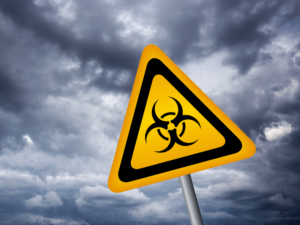
Can We Build Critical Infrastructure Resilience Before It Impacts Your Business?

If recent events, especially the COVID-19 pandemic, have taught us anything, it’s that the world is capable of changing rapidly and on a large scale without much warning. And doing so in ways that can have a profound impact on how people live their lives and how businesses function. It’s more important than ever for businesses to be aware of and prepared for black sky hazards that can cause significant disruptions, not unlike the pandemic. And to do that, all you need is critical infrastructure resilience.
Black sky hazards are anything that disrupts the normal functioning of critical infrastructure in several parts of the world over a lengthy period of time. This could be a geomagnetic disturbance, high-altitude electromagnetic pulses, or even a cyberattack. It may only be a matter of when and not if a black sky hazard like this impacts people and businesses in several corners of the world. The question for businesses is whether they can build critical infrastructure resilience that can minimize the impact of black sky hazards.
Artificial or Natural
The umbrella for what constitutes a black sky hazard is quite large. Even more, events can be both natural and artificial. Most of us should be familiar to some degree with the power of Mother Nature and other environmental hazards, even if it stems just from watching coverage of huge events on TV. For instance, earthquakes can cause serious physical damage while also causing geomagnetic disturbances. Hurricanes and other cases of extreme weather can cause flooding and property damage in addition to power outages. With the effects of climate change becoming more evident, the severity of weather events may continue to grow in the future, creating more serious and dangerous complications.
At the same time, there are also a variety of artificial black sky hazards that have the potential to disrupt societies and normal business operations. For example, radio frequency weapons, also known as Intentional Electromagnetic Interference (IEMI), are a new type of weaponry that can wipe out hard drives, destroy microprocessors, or even lead to electric arcing in transformers and other power system components. Also, if there were to be a nuclear detonation, even in the upper part of the atmosphere, it could lead to an electromagnetic pulse powerful enough to impact entire continents.
In today’s world, both physical and cyber-terrorist attacks have the potential to knock critical infrastructure offline. A physical attack on critical infrastructure could lead to power outages across a vast area for an extended period of time. Cyber attacks could also target information related to national security, as well as infrastructure related to hospitals, water supplies, and other aspects of our society that relate to keeping people safe and healthy, disrupting supply chains and other businesses along the way.
Why Are Black Sky Events So Dangerous?
Aside from the obvious, it’s vital we recognize why black sky events threaten people, businesses, and society at large. While modern technology has created capabilities that would have exceeded our imaginations even a decade or two ago, it has also made many aspects of our world interconnected and dependent on one another. The world’s infrastructure, supply chains, utilities, goods, and services are all tied together in a way that makes them interactive.
Therefore, if one of these areas fails, the rest become vulnerable to the same fate because they have become interwoven and interdependent on one another. If one key service or part of the supply chain becomes disrupted, it can have a cascading effect throughout the globe. And this is what can lead to what we might call a black sky event that has catastrophic consequences for people and businesses worldwide.
In a way, black sky events are similar to the butterfly effect. A small disruption created by an artificial or natural hazard may not seem like a global crisis on the surface. But because of the interconnectivity of our world through the use of modern technology, small issues can quickly snowball into larger problems impacting all corners of the globe and/or having a lasting effect without a quick fix. This is why there is a growing need for both individuals and businesses to have critical infrastructure security to build resilience and protect against a powerful yet fragile system.
Practice Exercises for Building Critical Infrastructure Resilience
One of the ways that a business can test its preparedness and readiness for a black sky event is with a practice exercise that mimics a catastrophic event. In these exercises, users are essentially playing a video game in which videos share information about the fictional situation and how things are developing. The severity of the situation typically increases over time, showing users how quickly things can escalate during a black sky event.
Part of the purpose of the event is to promote thought and discussion within organizations about how they would react to a particular situation. Would they be prepared for a major event? How much would normal operations be disrupted? What would be their priorities and best actions to survive such a serious event? Ideally, the simulation would allow a business to think about ways that they can better prepare for a black sky event and what changes are needed to achieve critical infrastructure resilience.
If nothing else, a black sky practice exercise can help a business to draw up plans for how they would respond to one or several possible catastrophic events. After all, black sky events may not be something that we can prevent ahead of time, but organizations can do their best to plan for them, reducing the negative consequences of such disasters as much as possible.
Communicating During a Black Sky Event

Perhaps the biggest challenge during a black sky event would be communication. Depending on the catastrophe, telecommunications might be one of the first systems to fail or one of the longest to get back online. On a larger scale, there are certain measures that governments and societies can take to help secure communication against the possibility of black sky hazards. But individual businesses can also work on their contingency plans for preventing communications disruptions, restoring communication, or finding alternative ways to communicate if there is a black sky event that knocks traditional methods offline. This is just one example of what it means to build critical infrastructure resilience.
Assess
In addition to looking at alternative communication methods that could be possible during a black sky event, businesses need to assess their readiness in other ways. For example, if part of their supply chain is cut off, do they have a backup or an alternative? If there is a global-scale cyber attack, is the company’s cybersecurity capable of withstanding an attack? If there are no clear answers to these and similar questions, is there a way to create answers to them? Remember that assessments are done to judge readiness before it’s too late. If a business isn’t ready for a black sky event, it’s best to find out ahead of time rather than during a catastrophe when it’ll be too late to be prepared.
Anticipate
Assessing a company’s preparedness is one step toward realizing critical infrastructure resilience. Businesses can take another step by trying to anticipate possible black sky events that could have a significant impact on their day-to-day operations. In fairness, some events will be hard to predict or anticipate. Obviously, it would have been asking too much for most businesses to predict the impact of the COVID-19 pandemic and prepare ahead of time for how it impacted our society.
Businesses run in areas where hurricanes, tornadoes, droughts, earthquakes, or other natural disasters are more likely, are able to anticipate -to some degree- a hazard occurring. With this information in hand, these businesses can take steps to prepare for a worst-case scenario.
Unfortunately, it’s becoming necessary for businesses to start prepping for more extreme scenarios. Natural disasters only seem to be getting worse with time, while the artificial events associated with black sky hazards can be just as damaging. Businesses need to start considering the worst-case scenario and finding the areas where they might be most vulnerable in those situations in order to find ways to be better prepared.
Think Outside the Box to Drive Critical Infrastructure Resilience

Perhaps the bottom line when it comes to critical infrastructure resilience is to think outside the box. As mentioned, this can mean anticipating events that seem too horrifying to envision coming true. It also means looking at factors that might be outside of your control and how to adapt to them. More than anything, it’s about being ready for anything that might come up. In this case, think about a loss of communication risk or power, as well as a disruption to your supply chain or anything that could disrupt normal business operations.
Obviously, governments at all levels also play a role in creating critical infrastructure resilience. But if that resilience isn’t there or isn’t ready for an unexpected or unforeseen black sky event, it’ll take time to adjust and get things anywhere close to normal in the immediate future. This is why individual businesses need to be able to ask themselves hard questions, anticipate the worst, and practice black sky events to ensure that they are as prepared as can be for huge disruptions and catastrophic events.
Need help preparing your business for all-scale hazards? Why not check out our EARTH EX exercise or attend our Resilient Renewable Planet Conference in April 2023? Both are great opportunities to learn from global experts, develop resilience strategies, and work with others in securing our future.
Create Impact with us:
Join our membership and
contribution programs
Participate in our
upcoming events:
Schedule a call with
our experts:
Cyber Resilience in the Energy Sector: Safeguarding the Grid from Digital Disruptions
In today’s interconnected world, the energy sector stands as a vital backbone of national and global infrastructures, facilitating everything from lighting our homes to powering industries. However, this sector is increasingly finding itself in the crosshairs of cybercriminals, making cyber resilience not just a matter of technological integrity but of national security. The concept of […]
The Role of Local Governments in Strengthening Infrastructure Resilience
The significance of local governments in strengthening infrastructure resilience cannot be understated. Often perceived as entities primarily focused on addressing routine community concerns and improvements, their responsibilities extend far beyond these day-to-day operations. In the realm of preparing for and mitigating the effects of large-scale, catastrophic events—referred to as “black sky” disasters—local governments emerge as […]
Navigating Complex Interdependencies and Building Resilience in the E-Sector
In today’s interconnected world, the electric sector is more than just a utility provider; it’s a cornerstone of modern life. Its influence extends beyond mere power supply, touching virtually every aspect of our daily activities, from powering homes and businesses to fueling transportation and technology. This pivotal role, however, is not without its complexities. The […]
